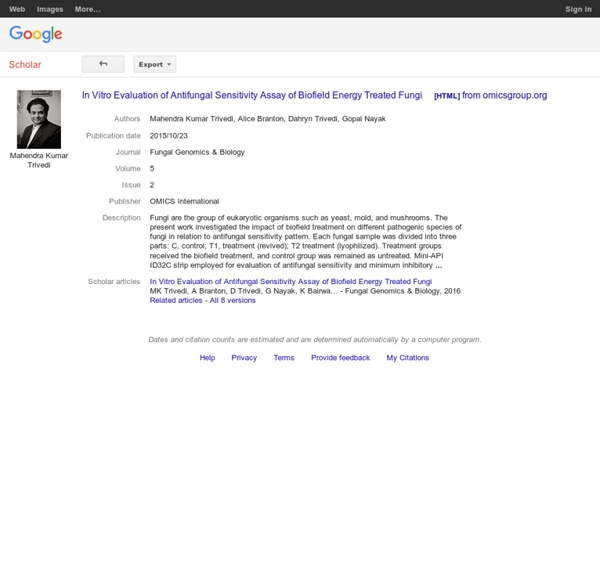



Effect of Energy Treatment on S. Epidermis Description Purpose: While spiritual and mental energies are known to man, their impact has never been scientifically measurable in the material world and they remain outside the domain of science. The present experiment on Staphylococcus epidermis [ATCC –13518], validate the effects of such energy transmitted through a person, Mahendra Trivedi, which has produced an impact measurable in scientifically rigorous manner. Methods: Staphylococcus epidermis strains in revived and lyophilized state were subjected to spiritual energy transmitted through thought intervention and/or physical touch of Mahendra Trivedi to the sealed tubes containing strain, the process taking about 3 minutes and were analyzed within 10 days after incubation. Citation Information Mahendra Kumar Trivedi.
Antifungal Sensitivity Assay of Human Energy Treated Fungi Description Fungi are the group of eukaryotic organisms such as yeast, mold, and mushrooms. The present work investigated the impact of biofield treatment on different pathogenic species of fungi in relation to antifungal sensitivity pattern. Each fungal sample was divided into three parts: C, control; T1, treatment (revived); T2 treatment (lyophilized). Citation Information Trivedi MK, Branton A, Trivedi D, Nayak G, Bairwa K, et al. (2015) In Vitro Evaluation of Antifungal Sensitivity Assay of Biofield Energy Treated Fungi. Evaluation of Staphylococcus Epidermis Polymorphism Abstract Purpose: While spiritual and mental energies are known to man, their impact has never been scientifically measurable in the material world and they remain outside the domain of science. The present experiment on Staphylococcus epidermis[ATCC –13518], validate the effects of such energy transmitted through a person, Mahendra Trivedi, which has produced an impact measurable in scientifically rigorous manner. Methods: Staphylococcus epidermis strains in revived and lyophilized state were subjected to spiritual energy transmitted through thought intervention and/or physical touch of Mahendra Trivedi to the sealed tubes containing strain, the process taking about 3 minutes and were analyzed within 10 days after incubation.
Staphylococcus Epidermis Antibiotic Susceptibility 3/10 Antibioticresistance,regardlessofantibioticandbacteria,willoccurwithsufficient timeanddruguse.Widespreadantibioticusecausesselectionpressure:resistantstrains survivewhilesusceptibleonesareeliminated.Antibioticresistanceisprogressive, increasingfromlowtointermediatetohighlevels[1]. characterizedbytheirrelativeresistancestoarangeofantibiotics. changedoesnottakeplacespontaneouslyinastrainovera10dayperiodofnormal incubationwithoutcontinuousexposuretoanydrugs InthispaperwereporttheimpactofspiritualenergyonStaphylococcusepidermis,in revivedandlyophilizedstate,withrespecttoitsantibioticsusceptibilitypatternalong withbiochemicalpropertiesanalyzedwithinaperiodof10days. transmittedthroughthoughtinterventionofanindividual,Mr. Asresponsesbyhumanscanbeaccountedforbytheplaceboeffect,theseexperiments
Yersinia enterocolitica | Impact of External Energy Description Background: While spiritual and mental energies are known to man, their impact has never been scientifically measurable in the material world and they remain outside the domain of science. The present experiments on Yersinia enterocolitica [ATCC –23715], report the effects of such energy transmitted through a person, Mahendra Trivedi, which has produced an impact measurable in scientifically rigorous manner. Citation Information M Trivedi, S Patil.
Biochemical Reaction- Yersinia enterocolitica Two strains of Yersinia enterocolitica [ATCC –23715] were procured from MicroBioLogics in sealed packs bearing the same ATCC number and stored according to the recommended storage protocols until needed for experiments. The study was grouped as per the following. Group I One of the two sealed packets was handed over to Hinduja Microbiology Lab and was revived by them in two separate tubes, of which one was the control. susceptibility and biochemical reactions as per the standard protocols of sample processing in the microbiology lab. The second tube, (ATCC ‘A') having viable bacterial culture, was handed over to Mr.Trivedi for treatment, after sealing by parafilm. Treatment Mr.Trivedi held this tube in his hand under ambient conditions for between 0.5 to 3 minutes while treating it through his thought intervention process by communicating and instructing the experimental object within the tube in order to undergo the change. Group II reactions. Behring Siemens) using NBPC-30 panels. MicroScan
Study of Biochemical Reaction on Citrobacter braakii Description Citrobacter braakii (C. braakii) is widespread in nature, mainly found in human urinary tract. The current study was attempted to investigate the effect of Mr. Trivedi’s biofield treatment on C. braakii in lyophilized as well as revived state for antimicrobial susceptibility pattern, biochemical characteristics, and biotype number. Citation Information Trivedi MK, Branton A, Trivedi D, Nayak G, Charan S, et al. (2015) Phenotyping and 16S rDNA Analysis after Biofield Treatment on Citrobacter braakii: A Urinary Pathogen. Impact of Unique Energy Treatment on C. braakii Research Article Open Access Trivedi et al., J Clin Med Genom 2015, 3:1 Volume 3 • Issue 1 • 1000129 J Clin Med Genom ISSN: IJGM, an open access journal Journal of Clinical & Medical Genomics Keywords: Citrobacter braakii; Antimicrobial susceptibility; Bioeld treatment; Biochemical reaction; Biotype; 16S rDNA analysis; Gram- negative bacteria; Enterobacteriaceae Abbreviations: MDR: Multi-Drug Resistant; ATCC: American Type Culture Collection; NBPC 30: Negative Breakpoint Combo 30; MIC: Minimum Inhibitory Concentration; OTUs: Operational Taxonomic Units; NCBI: National Center for Biotechnology Information; MEGA: Molecular Evolutionary Genetics Analysis; PCR: Polymerase Chain Reaction; RDP: Ribosomal Database Project; HBMEC: Human Brain Microvascular Endothelial Cells Introduction Citrobacter braakii (C. braakii) is a genus of Gram-negative, straight, facultative anaerobic and motile bacilli bacterium widely distributed in water, soil, and food in the environment.
Energy Healing Treatment: C. braakii Title: Phenotyping and 16S rDNA Analysis after Biofield Treatment on Citrobacter braakii: A Urinary Pathogen Publication: Journal of Clinical & Medical Genomics Select license: Creative Commons Attributions-NonCommercial-ShareAlike Updated: November 21st, 2016 Abstract: Citrobacter braakii (C. braakii) is widespread in nature, mainly found in human urinary tract. C. braakii - Biotype Number Analysis Abstract Citrobacter braakii (C. braakii) is widespread in nature, mainly found in human urinary tract. The current study was attempted to investigate the effect of Mr. Trivedi’s biofield treatment on C. braakii in lyophilized as well as revived state for antimicrobial susceptibility pattern, biochemical characteristics, and biotype number. Lyophilized vial of ATCC strain of C. braakii was divided into two parts, Group (Gr.) I: control and Gr. Keywords: Citrobacter braakii; Antimicrobial susceptibility; Biofield treatment; Biochemical reaction; Biotype; 16S rDNA analysis; Gramnegative bacteria; Enterobacteriaceae Introduction Citrobacter braakii (C. braakii) is a genus of Gram-negative, straight, facultative anaerobic and motile bacilli bacterium widely distributed in water, soil, and food in the environment. Materials and Methods Experimental design The impact of biofield treatment on tested bacterium C. braakii was evaluated in two groups- Group IIB – Study I Group IIB – Study II Gr.: Group